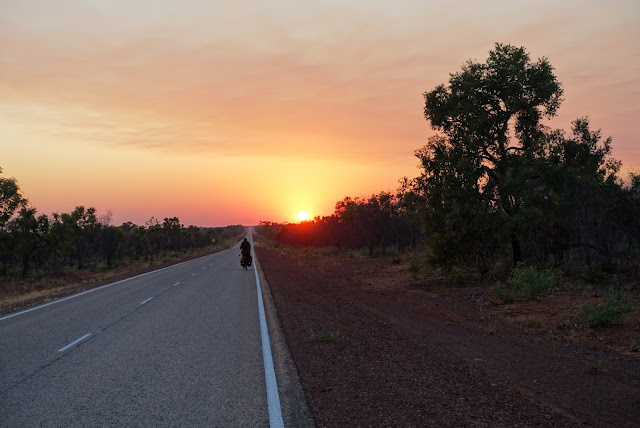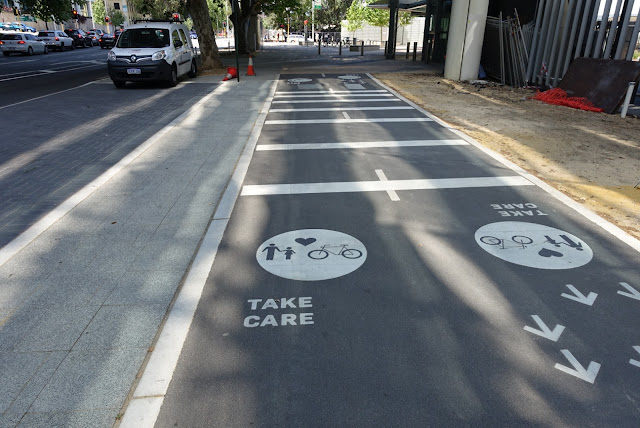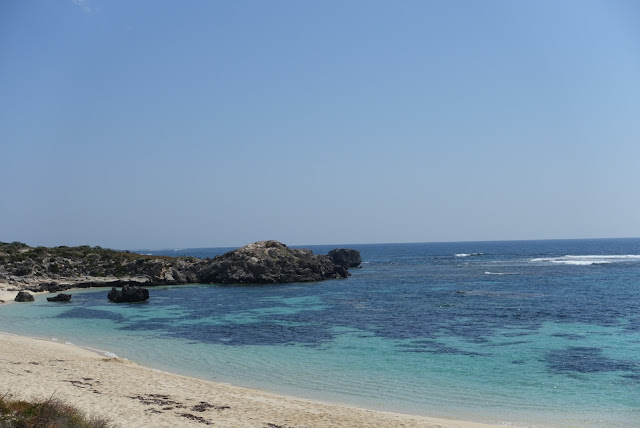While we were in Perth awaiting our new wheels to arrive from the east coast and some other parts from a UK order (which was ordered after but arrived before the parts from Melbourne, go figure) we went on a little side trip down the coast to Lake Clifton and to some breweries and wineries in that area. After visiting Rottnest Island and spending two nights at Fremantle in a cell in the old prison, we caught the train to Mandurah and headed south along the waterfront, then along Estuary Rd bike path, then old coast road to camp in some banksia and grass tree scrub at Lake Clifton.
 |
| Our cell for two nights in Freo |
 |
| Little pinnacles - limestone on the ride out of Mandurah |
Lake Clifton the township, has a rather amusing origin story. Initially set up as a township to house employees of a cement company in 1921 it was named Leschenault, but this was confusing because of Bunbury's Leschenault estuary, so they renamed it Garbanup, but the railways confused it with Dardanup, so in 1923 it was renamed Lake Clifton, but in the same year the cement company shut down and the railway moved away. What draws people to the area today is the Thrombolites.
Thrombolites look a little like brains sitting in shallow water. They are living rocks made by a film of (microbacterial) cynobacteria trapping sediments and are known as "living fossils" because they resemble life on earth at the dawn of time, a mere 3.5 billion years ago. If you manage to see them on a sunny day and when the water is low, they are an impressive sight from the boardwalk, all sitting around in the clear blue water. The spot is also great for birdlife, and its not a busy spot so you can usually enjoy the peace of the lake while you are there. Nearby the Cape Bouvard winery is a place you can grab a meal, although I wouldn't time it during a downpour because of the limits of indoor dining when they have reserved bus tour tables and certainly try to avoid the live entertainment if you can. Do not avoid, however, the ginger fortified wine. Grab a bottle of that.
 |
| Thrombolites at Lake Clifton |
 |
| Magpie geese at Lake Clifton |
 |
| Sunrise from camp near Lake Clifton |
Not far down the road is Lake Clifton Winery, which, when it is open, sells and offers tastings of delicious Mango wine as well as a range of other fruit wines, and also ginger wine. This wasn't open when we tried to visit, but I have visited it in the past and its well worth it.
We rode down to Australind, which involves riding the busy Old Coast Road and then the busier Forrest Hwy before you can peel off onto the quieter, rural road into Australind. We camped overnight at the Leschenault conservation reserve with its views of the inlet and access tracks to the surf beaches. The track in starts off sealed but ends up corrugated gravel for the remaining three or four kilometres. There are plenty of large Tuart trees and ticks to keep you company. Its a pretty place.
 |
| Leschenault Conservation Reserve beach |


The next day we rode back into Australind and then took the inland route north to Harvey before turning west along Forestry road to visit the Old Coast Road brewery (not actually on Old Coast Road at all). When we got there the place was hosting a wedding off in the corner of a paddock and the staff weren't much interested in serving the rest of the visitors as they were setting up for the post wedding dinner. Nevertheless we tried a few of the brews, including a very ginger coloured ginger beer. The brewery used to also be a distillery but that side of things is shutting down so we didn't get to taste whiskey. Probably just as well as we were already drunk from the beer. The brewery paddock is also used for sky diving, just in case getting married isn't enough of a jump for you. We stayed until we were kicked out at closing time and then rode across the road into the pine forest where we drunkedly put up the tent, entertained by wallabies who tried hiding behind trunks but forgot to tuck their long faces. "We can SEE youuuuuu". Eventually they all jumped away, having lost the game of hide and seek.
Finally our package from Melbourne arrived and we could put new wheels (with shiny new cassettes) and new chains on our bikes. After the silliness of watching the Back to the Future day DeLorean arrive in Perth city, watching 30-somethings in dress up walk around with hoverboards or crazy wigs, the next day we caught a train out to Midland and rode a few kilometres on some toxic roads to find the start of the Railway Reserves rail trail heading east over the range and through the beautiful John Forrest National Park.
 |
| Shiny new wheel |
 |
| Rail trail cutting |
The John Forrest National Park has some nice views, waterfalls after rain, and some great Western Australian wildflowers including Xanthorrhea and kangaroo paws. The rail trail has a good surface until it crosses the Golden Pipeline (that provides Perth water to Kalgoorlie) and turns into the Kep Track which is loose and more suitable to mountain bikes than loaded touring bikes. Bobtail lizards (Shinglebacks) wander across the path on occassion. At the end of the track we're in some tiny rural townships. We ride past a herd of Oreo cows with black or brown fronts and rears and white middles, like chocolate biscuits that come with their own milk. That night we camped near a brook on Baleup road in an unfenced lot full of grass trees and giant tuart trees, amongst the rusting junk and ticks.
 |
| Bobtail crossing |
 |
| Oreo cows |
Next morning we continue riding through the quiet rural scenery until we get to Tooleybuc road where it is far from quiet, as harvest and other trucks scream past us along with the steady traffic of commuters on this road without a sealed shoulder, and only loose red pebbled shoulder that your bike falls down on when you try to avoid being collected by something large on the road. Simons bike slips from under him at once point and he loses some skin on a hand, elbow and shoulder blade, leaving a tear in his shirt. We make it into the little town of Tooleybuc for some bakery fare, after quickly looking at the Avon river.
 |
| Avon river |
Next, we follow along some b roads next to the railway line. Occasionally trains pass by - grain carrying trains, the Prospector passenger train, and a locomotive shuttling empty passenger cars. But the quieter road ends and we're on another busy road, with no shoulder and lots of traffic. There are a lot of hills which means double lines and impatient drivers. While I'm riding up one long hill a bunch of cars narrowly pass me. One of the drivers pulls over at the crest of a hill, like an idiot. As I approach he gets out of his car and walks towards the road to yell some questions at me. I'm not stopping to answer them on this dangerous crest so I check behind me before riding up the middle of the lane to get away from him. He tries to ask Simon the same questions, but Simon tells him he's stopped in a dangerous spot. Back at Tooleybuc we had bought some giant rolls to take away for lunch, so a little up the road we stop to eat them. I tell Simon that the way some motorists treat touring cyclists is a little like the street harassment women experience. Unwanted attention, personal questions, intimidation, invasion of personal space, sometimes photos taken without permission, and if you just ignore them then you are the rude one and you'll get stuff yelled at you for that too.


After we get back on our bikes, the same guy pulls up to say some stupid remarks. I ride a few metres to get away from the idiot. He drives up to stop next to us again. I turn around so he can't easily follow me because he'd have to do a u-turn. He starts harassing Simon. This guy is like a weird stalker who just doesn't get that we don't want to talk to him. Just like women being harassed on the street simply for being there, we are not public property just because we're on two wheels and don't have a metal cage around us. We are not here for your entertainment.
We continue on, though wheat fields as far as they eye can see, with the occasional abandoned farmhouse turning to ruin. The flies in these areas, despite no visible cows or sheep, are horrendous. At one point I'm screaming down a hill when two kangaroos bound along beside me. I pray they don't decide to cross the road in front of me. They don't, and I manage to beat them in the race. I pound the air in victory. We make it to Goomalling (which apparently means place of the possums) by the afternoon and visit the IGA. As we sit on the pavement outside the shop, a monitor lizard skitters across the footpath next to us, and then across the road, its legs growing taller to race across, before it gets attacked by a magpie on the other side. We ride about 3 km out of town and camp early in some beautiful mallee remnant bushland next to the train line. Sometime in the early morning we're woken by a grain train with something like 40 cars creeping past, but its worth it to see the stars in the patches of sky between the towering silver-barked trees.
Next day we are starting to ride on quieter roads again, thankfully. Its still golden wheat from the edge of the road all the way to the horizon on both sides, with sometimes remnant mallee and wildflowers on the road edge or in patches separating properties. A kangaroo is spooked and jumps in large hops through a wheat field. It ducks down and is lost, but curiosity overwhelms and it pops its head up to look at us; the dark silhouette breaking the monotony of golden seed heads. As we approach Trayning (which apparently means Snake in the grass near a campfire) there is a sign for echidnas, but we don't see any. We head north and camp at White Mans Rock, which is down a dirt track in excellent condition. As we approach the sky lights up with sunset colours splashed on cloud, looking like an aurora. The rock itself is one large rock pointing up to the sky with smaller round rocks on either side, making you pretty sure the "White Mans Rock" name is a sanitised misspelling of its local name.


 |
| One of the many granite rocky outcrops that often feature waterholes |
 |
| Bounty of quandongs |
 |
| Wildflowers |
 |
| A burnt out harvester looking very Mad Max |
We are following a indirect route with lots of dog legs because the main route, the Great Eastern Highway, well lets just say there is nothing great about the Great Eastern. It has no sealed shoulder and is very busy, servicing just about all traffic heading Kalgoorlie way including road trains and harvest carrying grain trucks. The alternative it a jagged route that goes north and east and north and east before heading south to Southern Cross, which leaves us back on the Great Eastern Hwy the the 190 km stretch into Coolgardie and then the 40 km into Kalgoorlie. A series of thunderstorms bring us 30 km/h headwinds, and prevent us riding later than 3pm on a couple of the days heading into Coolgardie.
The first storm we manage to fluke out and camp on the edge of, as it turns out to be a severe storm, flooding the road, bringing down trees and cutting power lines only a few kilometres east of us. The sandstone we camp on refuses to take pegs so we hold down the tent with heavy panniers and try camping amongst the low wattle shrubs being battered by the strong wind. We get some heavy rain but not much, especially compared to the 42 mm received just a few kilometres down the road, and didn't see any hail that they got in Coolgardie that night. The next morning we dodge flood debris on the road, puddles, fallen trees that crashed across the road, luckily leaving a little space for us to get through. Further on work crews are chopping up fallen trucks and repairing the power lines. We make it into the small town of Southern Cross for lunch and Simon is buggered from the stupid headwind and rolling hills so we get a motel room at 2pm. On the Great Eastern Hwy you follow the pipeline. From the hills you can see four scars across the sandy heath country: a distribution line with access track next to it, the Great Eastern narrow two lanes of bitumen, the pipeline with pad next to it and further north a transmission line.
There have been wildflowers in abundance as we have travelled east from Perth - sometimes the ground plush with yellows, pinks or purples. Tall mulla mulla, a pink/purple flower that looks a little like a dishwashing brush (Ptilotus exaltatus) or the green variant Green pussytails (Ptilotus macrophalus). Yellows from Golden everlasting paper daisies (Bracteantha bracteata) or Yellow Top (Calochephalus platycephalus) or Fleshy groundsel (Senecio gregorii). Kangaroo paws in yellows, reds and greens. Purple sprays of Paterson's curse (Echium platagineum). Pink bottlebrush (Beaufortia schaueri) and the Geraldton wax like Astartea. Pink and yellow flowering Melaleuca. Leptospermum erubescens teatree looking like snowcover on shrubs. Flame grevillea delights with its bright orange along with other grevillea, hakeas and boronias. Eremophila alternifolia (Magenta emu bush) and Hop bush (Dodonea) give you reds. There are Xanthorrhoea preisii (grasstrees) with yellow flowering spikes, silver cassia (Senna artemisoides), Black-anther flax lily (Dianella revoluta), pigface, Smokebush (Conospermum stoechadis), new growth on Needle wattle (Acacia rigens) looking like the red colours through out of prism, Orange immortelle (Waltzia acuminata) and Thomasina stelligera which is only found in Coolgardie district. Saltbush and spinifex are also in flower.
We've also enjoyed clusters of Quandong trees in fruit here and there.
A quick flick through a book at the Kalgoorlie library (Australian medical plants) shows what a medicine chest these beautiful plants are (please do your research before trying your own remedies!). Dodenaea hop bush species were used for pain relief, headaches, snakebite, toothache, stingray or stonefish wounds, fevers, cold, flu and sores. Eremophila (Emu bush) for colds, headache, internal pain, coughs, colds, toothache, rheumatism. Melaleuca works on coughs, colds, aches, pains, headache, stomach cramps, asthma, aches and pains and wounds. Acacia roots or leaves for respiratory complaints, as antiseptic, skin lesions and sore eyes. Senna for fever and skin sores. Atriplex saltbush for scurvy and blood diseases. Portulaca pig face to cleans the blood. Spinifex for eye sores, skin sores (possibly those caused by walking through the prickly things), internal pains, infected ears or eyes. Grevillea inner barks as antiseptic skin wash. Hakea charcoal for treating burns and its sharp leaves to cure warts! Quandong is very high in vitamin C, can also be used for pain relief, swelling, springs, backache and sores.
But what can I take for all this hay fever?
Next we are riding across the Eyre Highway, the Nullabor before dipping into the South Australian coastal peninsulas on our way back east and home.
 |
| Masses of roadside wildflowers |
 |
| Storm building up over wheat field |
 |
| Ground wheat storage ready for harvest time |
 |
| One of the many salt lakes in the area |
 |
| Golden pipeline |
 |
| Storm building up |
 |
| Gravesite of three truckies who lost their lives in 2007 bushfire |
 |
| Mallee 40 km out of Coolgardie |
 |
| Coolgardie town hall with ufo moon |


















































 Sunrise behind us
Sunrise behind us  Kites flying down the road looking for breakfast (or a scene from Hitchcock)
Kites flying down the road looking for breakfast (or a scene from Hitchcock) 

 Black faced cuckoo shrike
Black faced cuckoo shrike 

 Brahminy kite takes a bath
Brahminy kite takes a bath 
 We missed the ocean. Hadn't seen it since Adelaide. Have traversed the continent in between.
We missed the ocean. Hadn't seen it since Adelaide. Have traversed the continent in between. 

 Crazy crab
Crazy crab 














